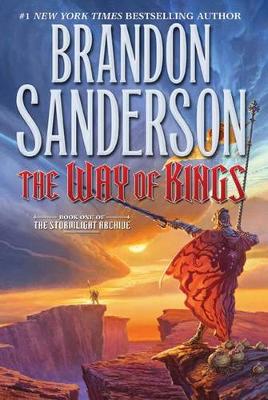Reviewed by Kate (Blogging with Dragons) on
An assassin stormed down the hallways of a palace with orders to murder the king in the most noticeable way possible. With a rare and legendary sword called a Shardblade in his hand, the assassin—cutting through both walls and men alike—made quite the statement. To his astonishment, what he found when he reached the king was no simpering noble, but a man ensconced in Shardplate, wielding a Shardblade of his own, and ready to fight for his life.
The ensuing battle between two characters that I hardly knew—complete with powers only hinted at by the author—was my first clue that this book would be extraordinary. My realization was confirmed moments later when the assassin succeeded in mortally wounding the king—and then to my shock—nobly carried out the king’s dying request. I hadn’t even gotten past the prologue and I was completely hooked.
However, there were times in the massive tome that I wasn’t quite as captivated. The fact that I only had to muddle through a few parts in a book over 1,000 pages was quite the feat. Sanderson did a good job of making sure that there was always something in his sprawling universe to keep his readers interested. And with his technique of changing character perspectives, there was a certain element of suspense involved—when I visited one character, I instantly wondered what was going on with others.
Though for me, a large part of this tension mainly involved, not my anticipation of finding out what was happening to certain characters, but my dread of returning to the narration of my least favorite character, Kaladin. Unfortunately, no matter what I did, I was unable to like this one character in what was ultimately a cast of very interesting and complex characters with unique backgrounds.
This was not to say that Kaladin wasn’t a multifaceted character—just that what little interest I could muster for Kaladin was reserved to flashbacks to his childhood. One would think that I found this boy’s development from a reluctant surgeon-to-be into a revered soldier who was then reduced to a slave, and then into a bridgeman, only to transform into a revolutionary leader referred to as Kaladin Stormblessed interesting, right? Wrong.
I couldn’t even pinpoint an exact reason or instance where my dislike for Kaladin originated, which is another reason why he bothered me. In fact, I knew that I had every reason to like the character and had the unnerving feeling that I should like him, but I couldn’t. Perhaps it had something to do with the old adage, “It is not about the destination, but the journey.” Maybe I felt that I had already reached Kaladin’s dismal destination and was unable to show any attachment to his present, where it seemed like his life was already over. Or possibly my love for the other main narrators—Shallan, a poor girl who sought to become an apprentice to a heretic scholar, and Dalinor, a solider and the king’s surviving brother who strove to uphold and instill a set of honor codes— made it that much harder for me to form an attachment to a pitiful man who seemed to have so much at ease at both giving up and getting back up. Whatever the cause, I remained indifferent to Kaladin and his many reoccurring struggles and anxiously awaited the shifting of perspectives so I could read about Shallan’s studies or Dalinar’s strange visions.
In the end, it was because of my frustrating and insurmountable dislike of Kaladin that I had to downgrade my rating of the novel to a 4 out of 5 stars. But even though I struggled to get through the parts of the book that focused on this character, I would still highly recommend this spellbinding tale to anyone—not just fantasy fans. With political intrigue, magic swords, warring races, mysterious visions, and a foreboding sense that disaster was looming—Sanderson’s book easily had something for all readers. Despite the sheer size of the novel, I flew through the book and as soon as I had finished “Way of Kings” I determined that I would not only read its sequel, but other books by the author.
Reading updates
- Started reading
- 24 August, 2014: Finished reading
- 24 August, 2014: Reviewed
